#zero waste sewing patterns
Photo

A nifty zero-waste halter dress for sunny days. I really appreciate the clever cutting. Tutorial by Mechiel Whitmore at Threads.
7 notes
·
View notes
Text
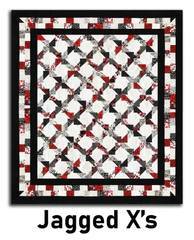
The (ALMOST) ZERO WASTE Jagged X's FREE Quilt Pattern! Tutorial
https://youtu.be/Ghg7aXt6qMc?si=24qtaIjeUylvYvAA Free PDF Pattern
#crafts#gifts#decor#quilting#sewing#briar rose quilts#bedding#shopping#quilt patterns#patterns#zero waste#jagged X#free pattern#free quilt pattern#quilters of tumblr
0 notes
Text
Helpful Tags
#crochet#pattern#cross stitch#cross stitch pattern#embroidery#dolls#barbie#stamps#stamp collecting#zero waste sewing#zero waste#sewing pattern#sewing patterns
1 note
·
View note
Text
Hmmm. thinking about overshot….
#I’ve always loved the aesthetic of overshot patterns but I also know I only really wear plain garments with mayyybe a lil texture#but then I was looking thru my grandmas saris and I thought. why not make a heavily patterned border with a plain body like a sari#then I could make a skirt out of thattt#of course I would have to actually learn overshot first#and then get better at warping#and then after all that I would have to make the skirt in panels because my loom is narrow lollll#I could just make a skirt out of one of the saris because I don’t wear them as saris#but I did that with my moms a long time ago and let me tell u#sacriligious#felt so bad#also it was silk which i had never worked on so#dress came out nice tho!!!#I actually paid attention to the pattern so it would look nice on the dress#and I used the petticoat for the lining so it was a real zero waste affair#all this to say….it seems my sentimental ass values my own weaving less than my grandmas clothing#she did give me those saris just to use as sewing fabric
0 notes
Text
picked up some linen fabric on sale here in kl so i can make another zero waste cropped shirt and try the style arc ethel pants pattern (photos are of those patterns) + i'm gonna try adding some patchwork knees a la these pants. the fabric for the shirt is a really nice warm brown and the pants are beige with some black and brown fabric for the patches... do u see my vision..
i don't have my sewing machine so i'm sewing it all by hand but i like handsewing and tbh prefer the quality of the garments made from it (i've never had a handsewn seam fail on me but i've had many machine sewn seams fail) so i'm rly excited to get started

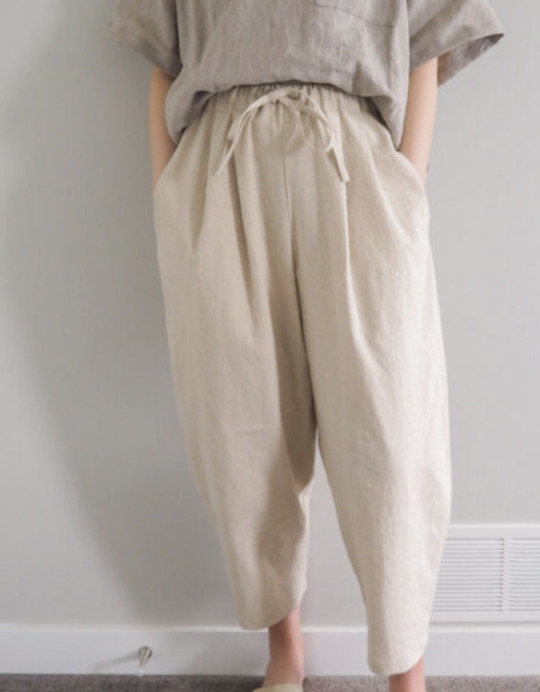
115 notes
·
View notes
Text
Be my muse
Chiori x fem oni reader
Summary: Chiori is trying to court her big oni friend but they’re too insecure to realize it.
A/n: I’ll be doing more fem oni x character series simply because its fun. But if there’s a certain character you’d like then let me know
“Hmm… maybe this blue would match your horns better.” Chiori, the renowned stylist in Inazuma had you stood on a pedestal standing straight as she threw at you a variety of kimonos and yukatas to wear. As a blue oni you weren’t accustomed to human society to well. Fashion isn’t really a big deal to Oni kind.. like at all… in fact most oni’s only wear thick and concealing garments in the winter. Most walk around with their chests exposed. As a blue oni you were also used to the scrutiny that you faced. Being considered a monster, a demon. All sorts of names.
Yet when you ran into Chiori one day while you were collecting lavender melons she seemed not to even consider you any different to herself. Even if you did tower over her, she showed zero fear. You couldn’t help but admire her as she would visit your hut in the wilderness on Narukami Island frequently. She was curious about your culture and your family but also your style. Turns out she HATED your pratical and unfashionable wardrobe and sought to make something better. According to her it is a crime that you decorate yourself with such hideous clothes. You foolishly challenged her to make something better than.
That’s thing about Chiori, she loves a challenge. Chiori loves to go outside the normal kimono patterns and flowing fabrics. She loves to experiment and draw inspiration from all over teyvat. So when you challenged her to make a outfit suited both for the life of a mercenary and a oni that still fits her stands of beautiful she saw a golden opportunity. You didn’t even have to pay a cent, but you did become her mannequin for the next few months.
“Look, Chiori I didn’t think you would take that joke so seriously.” You said as she placed yet another mock up on you. “I’m worried… shouldn’t you be making prettier dresses for your store?”
“You know its not like I’m wasting time. I’m still balancing my normal workload. Infact this is good because the more variety I can have the more attention I’ll bring.” She responds, not even looking up as she sews a piece to the slev
“I don’t think people look at mercenaries and wonder where they got their clothes.”
“They would if more mercenaries didn’t dress so hideously.” She remarks.
“Well..-“
“Don’t give me that practicality argument I’ve hear it all before. I’ve offered you a job as my assistant to which is significantly less dangerous.”
“My job isn’t that dangerous. I can handle the treasure hoarders and hilichurls with ease.”
“I don’t want you too though.” She says, you sense something different with her tone as she stitches a hole she spotted shut. Her hands moving the string as a spider weaves its web. It appears you’re too entangled in her strings to leave so easily now.
“I-I appreciate that.” You say. “But being your assistant would be difficult. I can’t travel with you..” you frown as you remember how she mentioned how she wanted to leave inazuma. You cannot however, being a Oni you were far removed from society especially In it’s paperwork. You have no travel papers or birth certificate because you born in a clan of Onis who saw no reason for such documents, your birth wasn’t officially registered with the Inazuma government as many others were. Which means you can’t legally travel outside of Inazuma. That’s what the lady in Ritou said at least.
“I’d stay if you wanted me too.” She said, her hands stopped their work as she looked up at you with a look that made you melt. “You’re beautiful you know, beyond your pretty face and soft hair… you’re far from what they say about you. You’re not a brute, you’re not even cruel, you have the biggest heart I’ve seen.” You can’t help but blush. She’s rarely as sweet as she is now.
“I don’t want to hold you back. You deserve to see the world, and I don’t want you to be stuck here.”
“If you could… would you go with me?” She asks. You pause. Leaving Inazuma would be a privilege. You only heard tales of the other nations and what it was like. You only saw a few trinkets from the other nations. What would it be like to feel the wind in Mondstadt, or to go swimming in Fontaine, supposedly you could breathe underwater. You’ve heard endless praise of the dishes in Liyue from the merchants you helped to escort. You even got to try one and you found they weren’t exaggerating. Perhaps you just never allowed yourself to dream of actually going there because you doubted that would ever be real.
“I would love to.” You say. “To explore the world with you would be a pleasure.”
Silence falls between you as you tense up. Did that freak her out? You weren’t sure if she was into you or not. Oni customs are quite different. You had read about human customs sure but you still couldn’t tell. She pulls away gesturing for you to spin around. You do.
“That Lady in Ritou.. she’s the one who told you that you couldn’t leave right?” She asked. You felt concerned, It wasn’t unlike Chiori to be a bit vindictive if she felt upset at someone.
“Yes, what did you do to her?”
“Well I had a word with her, and I found out she was full of it. You can easily file for a birth certificate as long as your parents come with you to testify its correct. It just costs a bit of mora.” She says going back to sewing.
“Yes I’m aware of that too. Its why I started my Mercenary career.”
“I could pay for it… save your money for the ticket out of here. Those government officals love to overcharge. Someone like you seems easy to fool. You’re too kind to them.”
“To be fair I have to be. If I’m even slightly mean or angry they act like I’m going on a rampage. My behaviors don’t just affect how they perceive me, but my entire species. I have to be calm otherwise they won’t even give me a chance.” You lament.
“I’ll be mean then, you know I have a bite to me. They can’t say anything if its me pushing on your behalf.” She says with a mischievous smile.
“But it could ruin your reputation.” You say
“With who? I could care less what they think of me. Those kind of people aren’t worth a cent of my time anyways.” She say’s confidently. “People don’t ask. Fashion designer to be their friend they ask a fashion designer to make them look good infront of their friends.” You smile as she again shuts down your worries about her. You’re not used to this. You’re used to fighting and arguing just to prove you have heart. You’re used to beans being tossed and always having to give a second chance when they realize they were wrong. You try to be understanding, you try to be otherwise you’ll be seen as unreasonable. But Chiori isn’t like that. She once kicked out a customer because they screamed at you throwing beans when you were just bringing her textiles in. She yelled at how disrespectful they were to her staff and that they wouldn’t ever be welcomed in her shop.
“Hey. Stop overthinking.” She smacked your face guiding you to look down. In your thoughts she moved to your front to start tying your custom obi.
“I’m not overthinking this time actually… i was just thinking about something.”
“If anyone in the outside world is threatened by you I’ll correct their assumptions. You really need to let me help you here.”
“Actually… i was just thinking about you…” you say, her eyes widen slightly, a rare sight as her confident frown is replaced with confusion. “You… thank you Chiori… I-I’m just..not used to someone like yourself…” you smile as she shakes her head briefly before regaining her composure.
“Its really not that big of a deal. Now, tell me.. did I surpass your expectations?” She says moving out of the way so you can see your new outfit in the mirror. You smile, not because its the most beautiful you’ve ever felt for a woman your size, but because she looks at you like you are one. Your confidence is boosted by the clear pride she exhibits in it.
“Even better than I could’ve imagined.” You say. She raises her head in pride.
“Well good, I can get started on the others now.”
“Wait what?”
“Well, you don’t expect to travel teyvat with only one fancy garment do you?”
149 notes
·
View notes
Photo

If you menstruate and are on a path of zero-waste, avoiding plastics, avoiding toxic chemicals, minimizing your footprint, or all of the above, then you’ve likely been faced with a frustrating conundrum: Menstruating is a natural part of your life, but there doesn’t seem to be too many ‘clean’, safe options to deal with it.
First off, let me say that I have been off and away from mainstream menstrual care for over 14 years, including birth control (wrecked my hormones), and storebought sanitary products (full of harmful chemicals like bleach, perfume and hormone-disrupting PFAs!). I have used silicone cups, discs, and cloth pads, and have a lengthy and thorough review of how they are used and what brands I prefer up on my Patreon.
However, for today I want to focus on one tried and true item: The pad.
Pads have been around for centuries- longer if you include their earlier predecessor, The Rag. However, in this time we’ve come pretty far to create a more secure, clean and manageable item— though the creation of the chemically-treated, plastic lined disposable pad has been a regrettable pit stop.
Cloth pads are great because they come in a wide range of colors and patterns (making them more appropriate for more kinds of menstruating people, including men and children) and can be reused for years if cared for properly. Over the past decade, they’ve gone from being available solely from independent sellers on sites like Etsy to being sold alongside menstrual cups in the ‘alternative’ period care section of many stores. You can also specifically buy pads made from organic or natural materials and avoid petrol-based textiles.
However, a downside here is that purchasing pads can still be expensive even if you aren’t buying direct from an indie seller. Now, it’s not that they aren’t worth every penny; having made 3 sets myself I fully understand the time, skill and materials that go into making them. But the fact of the matter is that under late-stage capitalism, paying the higher up-front cost for a set of reusable pads can be daunting, even if you know it’s cheaper in the long run (and it is).
If you have access to fabric, a sewing machine, and sewing skills, you can half the price, and I’m going to show you how. The cost of fabric can even be lowered by recycling old towels and clothing and I’ll talk about what you need in the tutorial! As a set of good cloth pads can last from 4-6 years or more, this is a great, frugal and eco-friendly option!
Additionally, I’m going to tell you how to wash and care for your pads since working with reusable pads is way different than just wrapping them up and throwing them in the trash.
For the step by step directions, photos and care tutorial, click here to read for free on my Patreon. All of my content is Patron-supported and Patrons also receive private and early-release posts! If you appreciate my work, feel free to visit my membership page and choose the tier that works for you.
Free tutorial here.
Tips + Thank yous
Insta
447 notes
·
View notes
Text
Sewing Zero Waste Culottes from The Craft of Clothes
Zero Waste Culottes From The Craft of Clothes
Behold! Fancy pants!

The pattern for these pants was one of my Christmas gifts. It comes from Liz at The Craft of Clothes, a zero-waste designer. I've really gravitated towards self-drafting and zero-waste sewing in the last couple of years, and this pattern has been on my list for a good six months, so I was excited to get into it.
Drafting
The first step (after reading the pattern through twice) is drafting the pattern pieces.
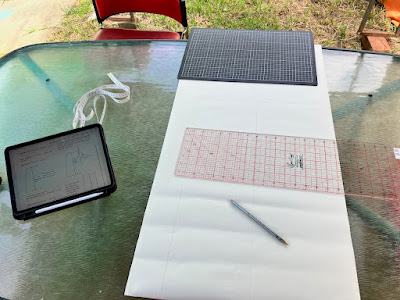
My biggest starting hurdle was deciphering "the culottes are designed to sit on your waist" when choosing the correct pattern size. Most designers consider "the waist" to be the teapot - that is, the true waist. (It's easiest to find if you bend to the side and stick your hand in the crease - like you're singing "I'm a little teapot".) But some consider belly button height to be "the waist". I generally wear my pants at the latter height, and there's a good 2" circumference difference between those two for me.
I eventually decided to call my belly button my waist, on the grounds that that's where I prefer to wear my pants. It's also easier to take seams in than out, if I guessed wrong.
Decisions over, it was smooth sailing from there. Pattern drafting is not a technically difficult process, as long as you have good instructions, and Liz's patterns definitely fit that bill. But there's a lot of attention to detail required to make sure the end result is good. That sort of thing always makes me nervous. Fortunately there was only two pattern pieces to draft, and they're 98% straight lines and based off rectangles.
Interestingly, this is the first zero-waste pattern I've tried that has you draft pattern pieces to use. The others I've seen (most by the creator of this pattern - our library had a copy of her book, Zero Waste Sewing) have had you draw directly on your piece of fabric to create the layout. (In fairness, I didn't have to draft my own pieces. The pattern came with the option of self-drafting, printing on A4, or printing on A0.)
I much prefer the direct-draw method to faffing about with pattern pieces. But given that this pattern is designed to have the pieces tesselate, having a set of physical pattern pieces does make more sense. It's also got me wondering if I could successfully make a pair out of old jeans legs, using one leg per pattern piece. But then, I'm always looking for ways to use up my denim pile...
Sewing
I prefer structure rather than flow in my butt coverings, so I was somewhat limited in my fabric choices for this first pair. (I know the fabric I really want to use, but I am being a sensible apprentice and trying things out on a nice-but-less-hideously-expensive fabric first.) Most of my stash acquisition has focused on stuff for shirts, since I wear those out faster than pants. I eventually settled on this nice brick red, 100% cotton, table cloth.
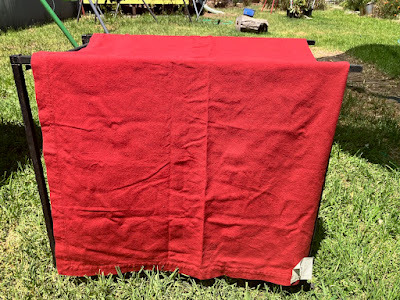
The picture is suffering from sun exposure. It's nowhere near this bright in person.
I laid out the pieces and huzzah! The fabric was just big enough! ... But only if I unpicked the hems (they're monsters, a full 3 cm/1.2" each side) and ironed them flat first. Thus, it was time for a marathon unpicking and ironing session.
After that was done, I checked the pattern fit again. Huzzah! I had enough space for all the pattern pieces, and not very much scrap left over once I'd cut them all out. (Of course, it was late and I wasn't paying as much attention as I should have been, so I didn't add an extra inch when I was forced to cut the waistband in two pieces. There was enough extra fabric that this was only an annoyance and not a complete disaster.)

The fabric at the top is scrap. All but a few inches of the stuff on the right became waist bands and plackets.
Sewing was a fairly straightforward exercise, though it required enough brainpower that I completely forgot to take any progress shots as I went. Almost every step of the pattern comes with a diagram to show you what to do, which helped me immensely. So did having the seam allowances specified at each point, as there's three different ones used in different places.
That's not to say I didn't screw up, of course. While sewing the crotch seam, I somehow managed to close up the front of the pants entirely and leave a gap for the placket open at the back. (That will teach me not to double check the direction the pockets are facing before I pin and sew that seam. Maybe.)
I also made a highly decorative and completely awful to sew with choice for topstitching thread, which I quickly became too stubborn to stop using. So the topstitching is, uh, not great. But it is purple and sparkly, and if I'd had any sense at all I would have left it til last (or even done some sort of hand embroidery with it).
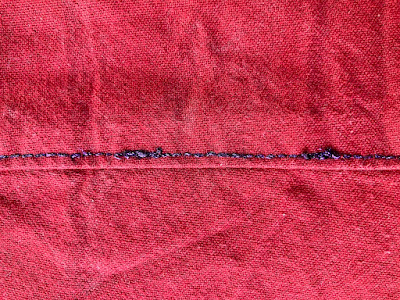
I was tricked by the first line of stitching being so easy. LIES. It was all lies.
Why should I have left it til last? Because it turns out that the culottes are, in fact, designed to sit on one's true waist. Which meant I had a two inch difference between what I needed to fit me, and what the waist measurement was. If I hadn't top stitched the panels, I could have simply ran another line of stitching down the seams that didn't have pockets in the way, and taken the waist in without much fuss or bother. Unfortunately, I didn't do that, so I was left with two choices.
Take out the topstitching and take in all the panels, bitching and moaning about the effort I went to and the number of times the topstitch thread broke while I was sewing the stupid sparkly goodness onto things.
Work out how to take the waist in by the necessary two inches, using only the crotch seam and maybe some darts or pleats or something.
Choice #1 would have been the logical, rational decision, so of course I went with option #2.
An hour and change of basting, pinning and unpinning the waistband, and completely forgetting how seam allowances work later, I managed to get a fit I was happy enough with. I ended up grading in a dart-like object at the centre back. (If I decide later that I'm not happy with the fit after all, I'll try out the modification for adding elastic to the back waistband that the pattern also includes. Probably while questioning my life choices and lamenting the amount of time I spend with a seam ripper in hand.)

The original stitching line is in blue, the new one is in black.
After all that fitting woe, I wasn't in the mood to try buttonholes (my good machine, the one with the automatic buttonholer, is currently out of action). Instead I dove into my snap stash to close the placket.

I love using bright, vivid colours for inner details. It's the sewing equivalent of wearing leopard print underwear.
A nice bonus of using the snaps is that I could put them through just the placket, leaving the fly front clean. This did make the placket pull slightly when I'm wearing the pants, exposing a trace of bright red. I fixed that by invisibly whip-stitching through the placket and outer fabric to hold everything in place. Next time I'll also double check the understitching, and topstitch the edge if needed, before installing the snaps.
Field Test and Adjustments
Trying stuff on as you go is all well and good, but nothing tells you what you really need to fix like being out in the field. I quickly discovered several things:
The waistband needs serious help to stay where it's supposed to be. Which, y'know, I did make a size larger than I should have. This was not surprising.
The crotch needs to either drop a wee bit or (preferably) rise a couple of inches. The latter will likely spoil the skirt-effect somewhat, but it will be far more comfortable for my legs.
I need a loop on the waistband to hold my keys.
For the waist woes, I had a few choices - 1) belt loops, 2) suspenders, or 3) add elastic to the back waistband. Belt loops are fiddly to make and sew on, but would solve the key-hanging issue. Suspenders technically wouldn't need any sewing changes, but the clip-on style are notorious for pulling off when you're doing things. And while the pattern includes instructions for adding elastic to the waistband, I wasn't confident it would do the job I wanted (I stick a fair amount of junk in my pockets and elastic can't always cope with the weight).
After some dithering, I went with the suspender option for this pair. I like the look of them, and the "floating" effect they give when they pull the waistband a bit above where gravity wants it to sit is extremely comfortable. But I didn't want to deal with clips always popping off. So I indulged in a quick side-quest of improving my suspenders, then sewed buttons into the waistband of the culottes.
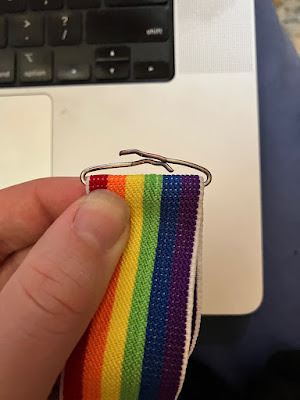
This used to hold the clips, but the wire was easy to bend flat with needle-nose pliers.
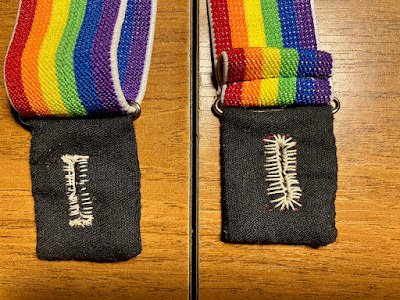
Gee, I wonder which buttonhole I did first?
Fashion Show
Overall, I'm quite happy with how it all came together. I'll definitely be making at least two more pairs - the "men's" version (less flare in the hems), likely out of recycled denim, and a pair in heavyweight stash linen.

The back panel adjustment is basically unnoticeable.

They have great range of movement - maybe I need to make a workout pair?
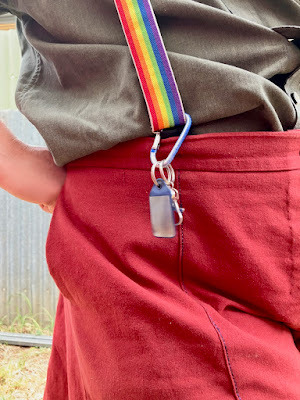
And I even have somewhere to hang my keys.
This post was originally published on my blog, Garak's Apprentice . I currently syndicate my content at Micro.blog, Tumblr, and Ko-Fi.

or Tip me via PayPal
49 notes
·
View notes
Note
Hi! Did you find a pattern for the coat you sewed for the crozier cosplay, or did you draft it yourself? It came out really well and I would like to sew it too
Thanks!
I drafted my own pattern, but the approach is very similar to this zero waste chore coat:
If you study how that pattern is drafted, you can make adjustments to match the on-screen coat, which will NOT be a "zero waste" pattern anymore because of the belt + different proportions. (So, make sure you have a lot of extra fabric. I used 10oz canvas duck, iirc.)
The hardest part is drafting the collar, and I just sort of did that by draping stiff paper, and later, canvas, on a dress form wearing the coat and cutting it til it looked right.
Here's me figuring out how to make the coat work on me (I'm as tall as Jared, but not as broad -- hashtag trans man problems):
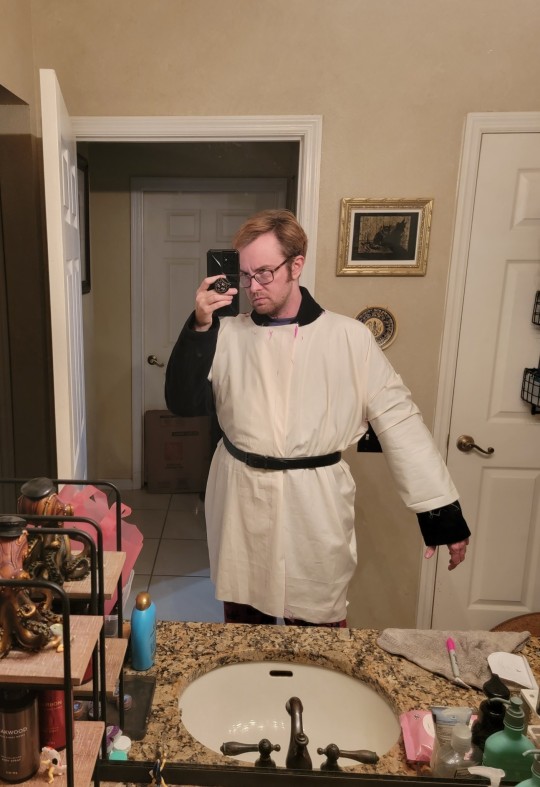
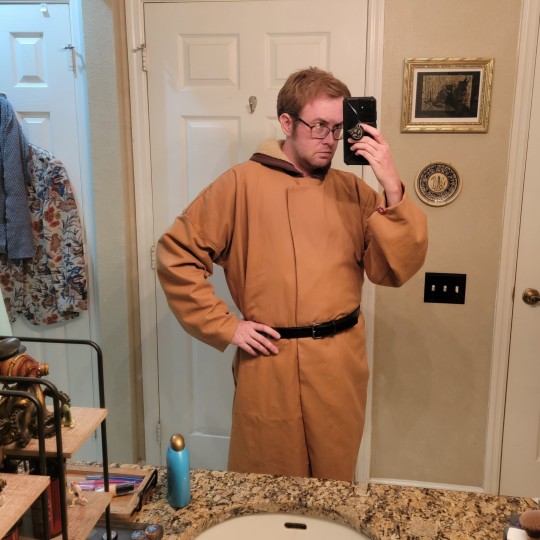
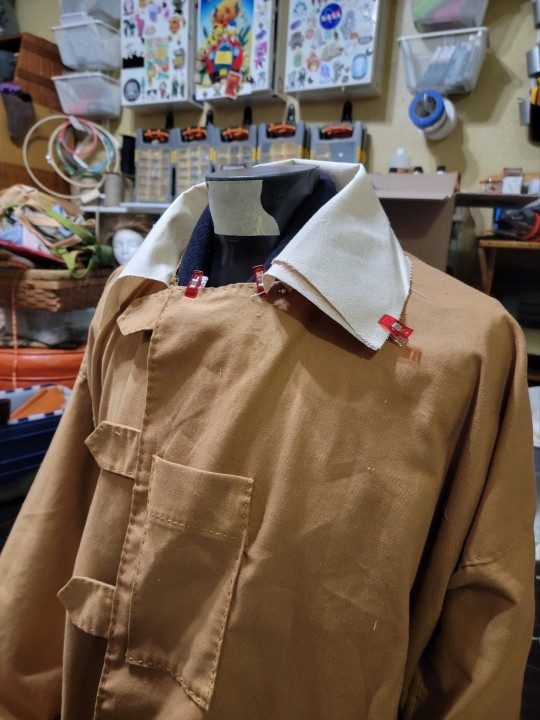
I also put in drawstrings in the cuffs to make them bunch up, which you can see here.
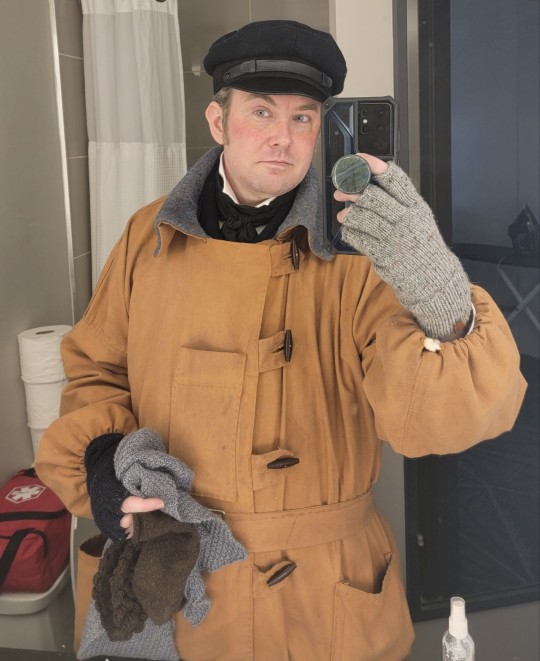
This was my first garment ever (my biggest goof was I cut the collar lining the wrong way on the fabric), but everything other than the collar and toggle thingies are just a bunch of rectangles sewn together, so it comes together fast -- just be aware the coat by design will be very large/loose and will look weird unless belted and worn over a jacket (I'm wearing a bog standard peacoat until my partner and I tackle the undress uniform). A muslin mockup will help you dial in the proportions.
Good luck!
60 notes
·
View notes
Note
Hi! I love your historical pants. Did you use an existing pattern, or did you draft your own? And if so... Do you sell patterns at all? I'd love to make myself a pair but I haven't learned enough to make my own patterns yet
Hello ! I got this question a lot so I hope you won't mind if I use it as a springboard to make a general public reply about it !
For reference, I started sewing a year and a half ago. I don't have any formal training and started from zero, so I kind of just rely on enthusiasm and trial and error.
For most of my projects, I use a mix of patterns and draping. I mostly do men's clothing and the patterns I find don't always match my body type exactly, so I rarely get to use them as is. I'm fairly tall and narrow so usually the smaller men's sizes are a good base, but not all patterns include sizes small enough, and there's still much to fix for me in terms of chest length, leg length, thighs, etc. That'll be something to keep in mind if you're smaller or more hourglass shaped for instance.
For the fall front trousers, it was kind of an impulse project, so I didn't work from a book and I bought a pdf pattern from Laughing Moon Mercantile. It was very useful to construct the front, which is quite complex by my second-year-of-sewing standards, but it only came in fairly big sizes so there was a lot of alterations to do pretty much everywhere else. Also worth noting is that the pdf is made for an A0 format, and although you can print it at home on a mosaic of A4 paper using Acrobat, it's impossible to select which "tile" section of the A0 page you want to print. The pdf pattern contains many options and printing everything to get just the pieces I needed was just too wasteful to do. Instead, I printed only the pattern pieces from the first page, and drafted/copied the missing pieces from other pages myself directly on pattern paper.
If you're willing to go through the printing and resizing hassle, it's a great pattern with very clear and exhaustive informations on construction and options for both historical and modern notions.
I picked that one because I wanted to do trousers specifically and it matched my needs best with many options to potentially combine, but if you're looking to do shorter breeches or just want to use it for the fall front, patterns are fairly easy to find on etsy or elsewhere. I like Reconstructing History because their smallest men's size works great for me and they cover a huge range of eras and styles. Unfortunately the instructions don't contain as many diagrams and are sometimes a bit more difficult to follow.
I almost never buy paper patterns so I can't recommend any. When it comes to actual historical garments that aren't like, halloween costumes, I find it very difficult to encounter paper patterns and I only find what I'm looking for in books or pdf patterns.
I find that both is best where you're a beginner ; the book gives great insight, and the pdf is a good base to work off. I'm still fairly new so I only have a few books (some of them physical, a lot of them pdfs, because they're expensive and sometimes out of print) but they're great classics and they help me a lot :
The Cut of Men's Clothes, 1600-1900 by Nora Waugh
17th Century Men's Dress Patterns by Braun, Costiglio, North, Thornton and Tiramani
The Medieval Tailor's Assistant: Common Garments 1100-1480 by Sarah Thursfield
Patterns of Fashion - Books 3 and 4 by Janet Arnold
Sorry this was so long ! If you're a beginner reading this, keep in mind I just threw myself at this with no prior experience quite recently and I'm having a lot of fun so go for it and don't be afraid to make mistakes and start over ! Good luck :)
325 notes
·
View notes
Text
Free Pattern Resources
I'm trying to gather free sewing patern resources. These are the ones i have so far please feel free to add your own. hoping to turn this into a masterpost sometime soon.
213 notes
·
View notes
Text
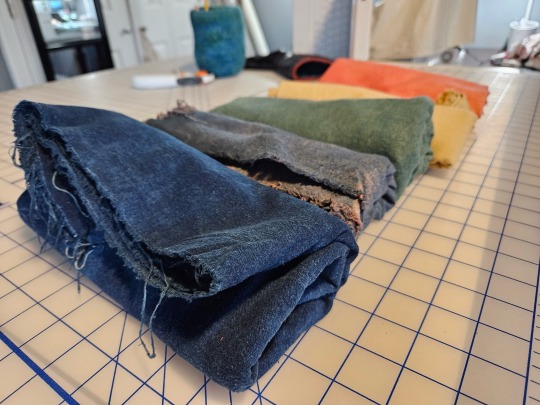
New year, new almost-certainly-fruitless resolution to burn down my stash (ha ha ha). I found a really elegant zero-waste shirt pattern that calls for exactly one yard of fabric per shirt, and the design looked just perfect for the five exactly-one-yard-long pieces of silk I dyed last year. I tend to hold on to “special” fabrics way longer than I should instead of using them, but this time I’m gonna do it! I’m gonna sew them!
The fabric above is Dharma Trading’s silk noil. From left to right, the dyes are:
Indigo
Madder overdyed with indigo
Myrobalan overdyed with indigo
Myrobalan
Madder
I don’t know why this fabric isn’t more popular - it’s delightfully soft, a little bit flowy, and a very reasonable price point for silk. Well, ok, I DO know why it’s not popular - blah blah blah polyester blah blah blah mass manufacturing etc etc etc. But I’m certainly planning to work it into my own sewing a LOT.

The cutting layout for this shirt is so ingenious! It truly is zero-waste, every scrap used, which feels really important for me with these hand-dyed silks that I worked so hard on.
11 notes
·
View notes
Text
Somewhere in me there is a rant about how “zero-waste” clothing that uses every inch of a rectangle of fabric in a garment isn’t necessarily less wasteful than a similar garment that uses shaped pattern pieces.
Inhale. Alright, bear with me.
I can make a pirate shirt out of rectangles and use up every inch of a piece of fabric if i lay the pieces out correctly. Is this actually less wasteful than if the shirt has a shaped armscye and neckline? So long as the pieces still fit onto the same original cut of fabric?
Or more relevantly, I recently saw someone brand their skirts as an adjustable, historically inspired, zero-waste design. It was literally an 18th century petticoat. Two rectangles of pleated fabric with waist ties for the front and back panels. Aside from the questionable ethics of claiming they designed this skirt, is it actually less wasteful?
People who sew know that generally speaking, a circle skirt is considered very “wasteful,” because cutting it in just one or two pieces requires an awkward amount of fabric, and the inner circle of the waistline is generally too small to use for anything (but it’s big enough for part of a pocket!). But if you divide the circle into pie slices, you can rotate each slice so that you can “top and tail” them across your fabric. And in doing so you can potentially achieve a wider skirt hem, even if you have to trim the hem into a curve. But according to “zero waste” methods of patterning, the gored skirt is wasteful while the pleated rectangle skirt isn’t. That makes no sense to me.
What is wasteful, in my opinion, is making more than you will realistically use, or things that won’t last, or things you’ll only wear once and then shove into a closet never to be seen again.
22 notes
·
View notes
Text
i get the point of zero-waste sewing patterns but also sometimes i feel like it's all like "make this sleeve bigger so you use up all of the fabric" and while i get the sentiment it's not like i would use more fabric if i made the sleeve more fitted ??? i would cut it from the same exact block of fabric and just use less of it. and then store the leftovers for quilting or details on other projects
#idk i feel like it would make much more sense if the spirit was “the tiny bits fit into the holes left by the big bits”#because god knows i've wasted fabric because the damn collar stand does not fit in the space between the other pieces
3 notes
·
View notes
Text
zero waste sewing patterns infuriate me because people present them as this inherently more environmentally friendly option for sewing things (because there are no fabric scraps left over, so you must have used the fabric to its maximal potential, right?) but in practice that's only even slightly true if it also uses less fabric, please stop telling me that your dress pattern that takes 2 metres of fabric and leaves no scraps is inherently better than my dress pattern that also takes 2m fabric and leaves two fat quarters of scraps that will sit in my stash until one day I make a quilt or some baby clothes out of them, or stuff a soft toy with the bits that are too small to use for anything else
#i HOPE this is a window into previously unknown discourse for most of you#it's a post more suited to my insta than my tumblr except that people might argue with me there#and i don't really want argue i just want a rant. to people who will agree with me because they don't know enough about the topic to#disagree#sewing#rowena adventures
12 notes
·
View notes
Text

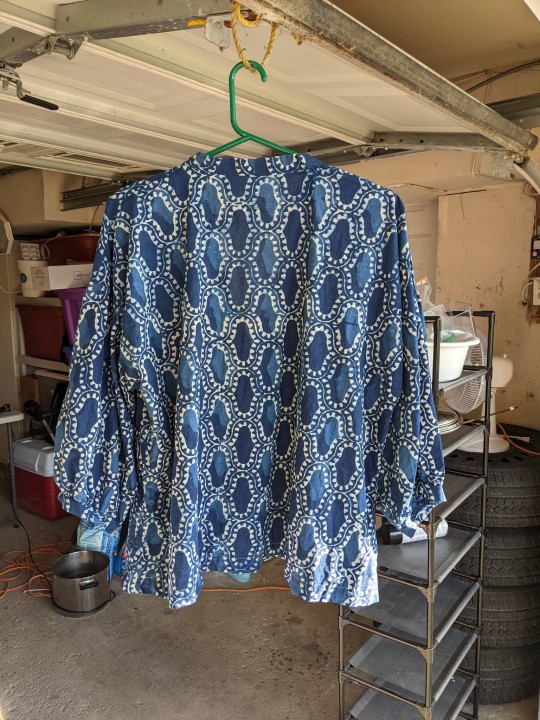


finally took some decent photos of the shirt i sewed a couple weeks ago! fabric is indigo dyed block printed cotton from india and the pattern is the zero-waste cropped shirt from birgitta helmersson 🧿💙 buttonholes were handsewn with white-blue ombre perle cotton thread.
393 notes
·
View notes